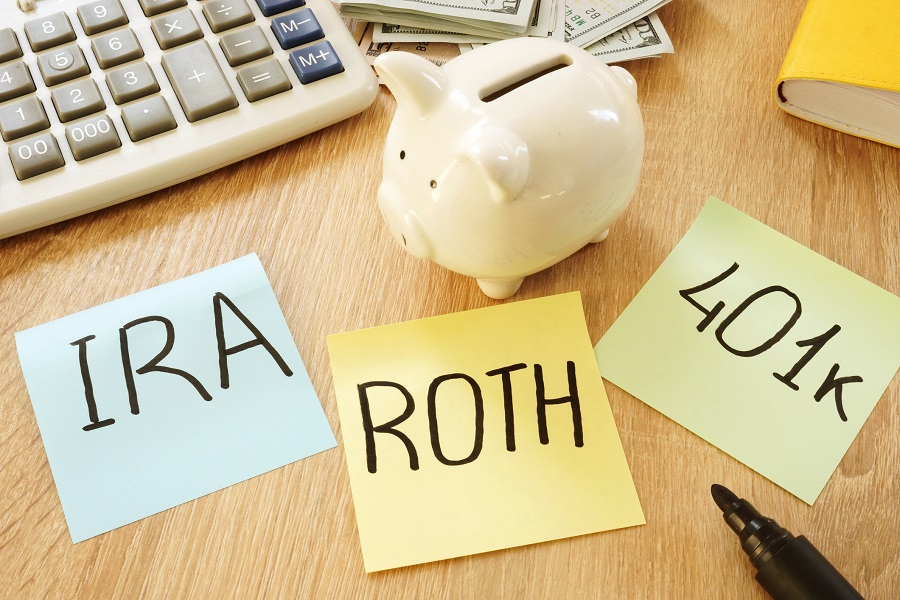
Tax Strategy in Retirement: 10 Tips to Save on Taxes
Tax Strategy in Retirement: 10 Tips to Save on Taxes
The word retirement can bring up all sorts of emotions, such as excitement and joy, anxiety and fear—all things to consider when thinking about tax strategy in retirement. There are many ways to save on taxes in retirement, such as moving to a lower-tax state and taking advantage of tax breaks like IRA contributions and IRAs. Still, there are also plenty of ways that retirees can end up paying more tax than they expect. Read on to learn ten tips on how to save on taxes in retirement so you can truly reap the benefits of the golden years.
1) Contribute to your 401(k) if you can
Making contributions to your 401(k) is a great way to reduce your taxable income during retirement. The current limit for 401(k) contributions is $18,000. If you’re 50 or older, you can contribute an additional $6,000 in catch-up contributions. Contribute as much as you can afford
And if possible, be sure that all of your pre-tax dollars (income less any deductions) are going into a tax-advantaged retirement plan like a 401(k). Contributing pre-tax dollars will reduce your annual taxable income—meaning more money will go towards reducing your tax bill! You can also consider contributing to a Roth IRA. A Roth IRA offers after-tax contributions, meaning you pay taxes upfront, but withdrawals are tax-free during retirement. Disbursements are especially useful if you expect your income to be higher during retirement than now or your tax rate will increase. Roth IRAs also have no required minimum distributions once you turn 701⁄2. Therefore, afterward, your money can grow tax-free until you decide how much (if any) you want to withdraw each year.
Finally, consider increasing your retirement savings by making more contributions to your current employer’s 401(k) plan, investing through a Robo-advisor, or starting a side hustle. If you’re over 50, you can contribute an additional $6,000 annually, which is just icing on top of a sweet tax-free cake! You may have heard that saving for retirement and college are mutually exclusive—this isn’t necessarily true. Maximizing both types of savings accounts is one way to optimize your financial health.

2) Leverage tax-free investment accounts
As your income rises, it may make sense to start using tax-free investment accounts like Roth IRAs and 401(k)s. When you contribute to a traditional IRA or 401(k), taxes are withheld from your paycheck, lowering your net income for that year. But when you invest in a Roth IRA or 401(k), you’re not getting a tax deduction up front; instead, it’s free of taxes when you withdraw money later in life. So why would someone who is already paying less (or no) tax use a Roth? It all comes down to taxes during retirement. In general, people tend to pay fewer taxes during retirement than while working.
Keep your tax-free investments separate from other money you don’t want to pay taxes. You can do that by opening different investment accounts for each and making sure you only deposit pre-tax dollars into your tax-free account. For example, if you contribute $2,500 per year to a Roth IRA, do not also deposit that $2,500 into a standard investment account or other savings account that’s already taxed. If you do, there will be no benefit when it comes time to withdraw. Even worse, there could be an additional penalty because some of those contributions may have come from pre-tax income.
Lastly, don’t forget that you can roll over money from a 401(k) into a Roth IRA. If you are getting close to retirement age, talk with your financial adviser about what accounts might work best for your specific situation. The last thing you want is to end up taking money out of your investments early and paying more than necessary in taxes.
3) Consider maxing out your Roth IRA
Contribution limits are relatively low, but they don’t have to be. When you’re younger, it can make sense to put more money into a Roth IRA since your tax rate is likely higher than it will be later in life. You’ll also have fewer retirement accounts later in life. This is why it is critical to plan for the long term now while you are younger. You can always make a backdoor Roth contribution once you’ve maxed out other accounts (see #5 below). If maxing out a Roth IRA doesn’t make sense for your specific situation or goals, consider contributing enough money to hit the maximum 401(k) and IRAs before putting any more money into your employer plan.
The last thing you want is to save a ton of money for retirement, only to owe taxes on it when you withdraw. So clearly, a tax strategy in retirement planning is vital. There’s no tax deduction upfront with Roth IRAs (as with a traditional IRA), but that means you don’t pay taxes on any distributions later. If your income is high enough, your contributions may be subject to income tax when you put the money into an account. Still, your qualified distributions will never be taxed. Check out our Roth IRA Basics guide or read about how a Roth IRA works. Fidelity Investment’s 401(k) calculator can help determine how much to contribute based on your goals and current situation.
You won’t owe taxes for traditional IRAs when your money goes into an account. Still, you will have to pay taxes on any distributions. However, like a Roth IRA, qualified distributions are tax-free (except for any capital gains). Depending on your income and other factors, you may be able to deduct some or all of your contributions (although if you make more than $70,000 and file married filing jointly, that deduction is phased out completely). For more information about IRA contribution limits and eligibility requirements for traditional IRAs and Roth IRAs—as well as information about allowable IRA investments—check out our Individual Retirement Accounts guide. Our calculator can help determine how much you should contribute based on your goals and current situation.

4) Use after-tax dollars for nondeductible IRA contributions
For higher-income earners who aren’t saving enough for retirement, you can use after-tax dollars to make nondeductible IRA contributions. For example, if you earn more than 58k as a single filer or over the 92k filing jointly bracket, you cannot take a deduction for any contributions you make into a traditional IRA—but there’s no reason why those same dollars can’t be put toward nondeductible gifts.
$3,000 is a substantial saving over $5,500. Remember that once you turn 70 1⁄2 years old, you can only withdraw money from a Roth IRA if you’ve had it for at least five years and your account has been open for at least five years as well. However, these rules don’t apply to nondeductible IRA contributions, so there’s no need to be concerned about taking advantage of them now. Your distributions will still be tax-free at age 59 1⁄2 even though they aren’t penalty-free until after age 59 1⁄2.
You may have heard that you’re required to take distributions by April 1 of each year after reaching age 70 1⁄2, but you don’t have to make withdrawals at all if you don’t want to. You just need to plan ahead. Again, this is why it goes without saying, having a tax strategy in retirement is more than beneficial. If you don’t need money from your nondeductible IRA contributions and want a way to defer tax on your income, consider taking advantage of using after-tax dollars for a nondeductible IRA. Just remember that once you reach age 70 1⁄2, it will be mandatory for you (unless granted an extension) to begin taking minimum required distributions from all IRAs—including Roth IRAs. The same is true for traditional IRAs as well.
5) Best tax strategy in retirement is flexibility
It’s possible to structure your life insurance so that you can access cash value over time. In other words, instead of taking a death benefit payout or cashing out your policy, you can take some (or all) of it as a policy loan. That loan can be used for any purpose—including paying off debt, spending money during retirement, or investing for future income. The interest paid on these loans is tax-free and will reduce your net cost of insurance.
You can also use your life insurance policy as collateral for a loan. Most policies will allow you to take out a loan against your cash value, and, in some cases, you may be able to use all or part of your death benefit as collateral for that loan. If you’re planning on taking a lump-sum distribution from your policy, you might consider using all or part of it toward a down payment for an investment property. You can then get a home equity line of credit (HELOC) against that property to keep it as an investment property instead of selling it and buying something less tax-efficient—and if anything happens to you and your spouse during retirement, there won’t be any taxable gains left behind when probating your estate.
Tax-free distributions from your qualified retirement accounts can be used for any purpose, and that includes paying off debt. Suppose you have a traditional IRA or another pre-tax retirement account. In that case, you can roll over those funds into a 401(k) or similar employer plan if you have one. If not, consider using part of your retirement savings for a down payment on a tax-free investment property—that way, you can also get an above-market mortgage rate if necessary. You’ll still have access to that cash later—and even better, it won’t add to your taxable income when it goes back into your IRA (or another retirement account).

6) Invest through solo 401(k)s, multiple IRAs, and self-directed IRAs
A solo 401(k) is an excellent tax-advantaged retirement account because you can contribute up to $50,000 of pre-tax income into your plan each year. Additionally, you can contribute an extra $6,000 each year if you’re 50 or older. However, one downside is that it doesn’t allow after-tax contributions like traditional IRAs do. Traditional IRAs allow additional contributions above and beyond what your employer matches as long as you have earned income. When it comes time to start withdrawing funds from these accounts, make sure that you first pay attention to any required minimum distributions (RMDs) depending on your age; RMDs will need you to begin taking a certain amount from traditional IRAs starting at age 701⁄2.
It’s possible to invest in several different types of IRAs. You can contribute up to $5,500 ($6,500 if you’re 50 or older) per year into a traditional IRA. Suppose you have access to a 401(k) at work. In that case, you can participate in both as long as your contribution does not exceed IRS contribution limits ($18,000 if you’re under 50 and $24,000 if you’re 50 or older). This is referred to as backdoor IRA contributions because it requires contributing first through a 401(k), which provides valuable tax-deferred growth. If your employer doesn’t offer a 401(k), consider opening an IRA account through your bank or brokerage.
If you have access to a 401(k) at work, make sure you know what type of account it is before contributing. Many companies offer both traditional and Roth 401(k) options; while they’re both excellent choices, their tax implications are vastly different. The vast majority of people should contribute to a traditional 401(k), which allows your investments to grow tax-deferred until retirement when you pay taxes only when making withdrawals. When deciding between a traditional or Roth IRA, it comes down to what your best tax strategy in retirement will be. Also, how much money you expect your tax rate will be at retirement vs. your current marginal income tax rate. Those who anticipate being in a lower bracket at retirement should choose Roth IRAs over traditional IRAs, as withdrawals are made without paying taxes upfront.
7) Consider making nonretirement withdrawals from a Roth IRA
Take nonretirement distributions from a Roth IRA before age 591⁄2. You must pay a 10% early-distribution penalty tax on those amounts and may also owe regular income taxes. But if your modified adjusted gross income (MAGI) is less than $100,000 for single filers or $199,000 for married couples filing jointly (if either spouse is an IRA owner), then you’re eligible to pay taxes only on earnings from contributions—not on withdrawals of gifts—in addition, to spend just a 10% early-distribution penalty tax. Note that these limits apply whether you make nondeductible contributions or use already-taxed money to fund your IRA.
Roth IRAs were designed with two distinct goals in mind. One was that you should pay no taxes when making withdrawals of your contributions—only gains. The other was that those gains should be completely tax-free, providing a way to get around paying taxes on early distributions from traditional IRAs. But early distribution penalties and taxes will still apply if you make nonretirement withdrawals from your Roth IRA if you’re under age 591⁄2 or your MAGI exceeds $100,000 for single filers or $199,000 for married couples filing jointly (if either spouse is an IRA owner). Consider converting part of your traditional IRA into a Roth.
If you have a traditional IRA, you can convert it into a Roth—provided that you meet certain income restrictions and don’t owe taxes on early distributions from other IRAs. When you convert your IRA into a Roth, your MAGI must be less than $100,000 for single filers or $199,000 for married couples filing jointly (if either spouse is an IRA owner). There are three methods of conversion. You can recharacterize your IRA by making a trustee-to-trustee transfer back to your traditional IRA within 60 days. Or you can make two separate transactions by first taking out all of your contributions from your traditional IRA (leaving behind only gains) and then converting those converted funds into a Roth.

8) Take advantage of catch-up contributions
If you’re 50 or older, you can put an extra $6,000 a year into your IRA or 401(k). That’s called a catch-up contribution, and it can help boost your savings. And if you’re self-employed, there’s no age limit on catch-up contributions. However, when you contribute more than that amount each year to either type of account (combined employer/employee contributions), the additional amount is considered excess and subject to penalty and taxes. However, if you plan now, by saving ahead, you will have a solid tax strategy in retirement. Additionally, plan sponsors may set a lower upper limit on total annual employee deferrals. To be safe, check with your company before contributing over the 6k limit to your retirement accounts.
In addition, contributing more to can sometimes backfire. For example, contributing $7,000 to a traditional IRA comes with a price tag of about $600 because of taxes on excess contributions. In comparison, you are making an extra $6,000 catch-up contribution to a Roth IRA has no tax consequence at all. So if you’re 50 or older and eligible for catch-up contributions, it’s generally better to contribute up to that amount into your 401(k) or traditional IRA and then make an after-tax ($6,000) contribution into your Roth IRA instead.
If you’re self-employed, start a business retirement plan (like a SIMPLE IRA or SEP-IRA) and make contributions for yourself. Employer contributions into those plans are tax-deductible. Employer matching can be an effective way to boost your retirement savings. Note that after-tax SIMPLE or SEP IRA contributions are made with funds from your taxable income and will impact what’s reported as adjusted gross income (AGI). This may increase or decrease certain tax deductions based on AGI levels. But any money contributed into a 401(k) plan is pre-tax, which means it won’t impact AGI or itemized deductions.
9) Itemizing your deductions isn’t always the best approach
When calculating your itemized deductions for a solid tax strategy in retirement, consider considering charitable contributions and mortgage interest—it’s not always worth it. Your deduction for mortgage interest and property taxes may be limited if your income is higher than $100,000 ($50,000 if you’re married filing separately). And once you’re above a certain income threshold ($75,000 if single or $150,000 if married filing jointly), you won’t be able to deduct those charitable contributions at all. If that describes your situation, consider taking only the standard deduction—which varies depending on your filing status but is currently $6,350 for singles and $12,700 for married couples.
Instead, you may want to focus on deductions that are completely unaffected by your income. You can take a deduction for medical expenses that reach 7.5% of your adjusted gross income, and interest paid on student loans can count as well—though it’s limited to $2,500 per year. If you work from home or have other expenses related to being self-employed, those qualify too. Write off every legitimate cost you incur because no matter what deduction it is—or whether it’s subject to an income threshold—every dollar counts when it comes time to file taxes! To see what your tax rate will be once all those deductions are taken into account, use a financial calculator and make sure you don’t miss out on any that could save you money come April!
If you’re unsure about which direction to go, a tax advisor or financial planner can help. They’ll make sure you get all of your deductions while also making sure they add up to something worthwhile—in other words, that those deductions won’t push you into a higher tax bracket. And suppose your income is high enough that certain itemized deductions are off-limits. In that case, a few strategic changes could make filing easier on your budget. One option is asking your employer for more pre-tax contributions into retirement accounts like 401(k)s and 403(b)s so you don’t have to worry about coming up with post-tax money later.

10) Monitor your effective tax rate each year
One of the easiest ways to save money on taxes is monitoring your effective tax rate. That’s an annual calculation that reveals how much money you pay in income taxes as a percentage of your gross income. Suppose it turns out you are paying more than 25% (the upper range for most taxpayers). In that case, you might be able to plan some moves—like when and how you withdraw from accounts, where and when gains are harvested, etc.—to reduce your overall tax burden for that year. It’s just another way tax planning can help keep more of your hard-earned money! Most investors have no idea what their effective tax rate is until after filing their taxes for each year.
If you’re like most investors, though, you probably don’t know what your effective tax rate is until you’ve filed your taxes for each year. Try looking at your overall portfolio from a holistic point of view—the sooner, and more often, than better! Your plan for adjusting any elements of your portfolio that can be changed to influence taxes should depend on what stage of life you are currently in. How long do you have before retirement? Do you even have a tax strategy in retirement? What are your goals for current account balances and annual income when retired? If saving up for retirement is part of your plan, how much money will likely go into different accounts (e.g., IRA vs. 401(k))?
And remember, if you’re not sure what tax strategy might make sense for your situation, talk to a CPA or another financial advisor who can help. There are many ways tax planning strategies can be tailored to fit an individual investor’s specific needs, and it never hurts to have extra eyes on your accounts! If you’re saving for retirement, paying attention to your effective tax rate and overall portfolio is critical—even more so than when you’re planning other aspects of your life. Saving more money on taxes can also give you a little extra cash flow each year, which might make it easier to hit all those goals while keeping more of what belongs to you!

How I can help
While taxes are a touchy subject, there is no reason why you should be paying more than you need to. As you approach retirement age, your tax strategy in retirement should change slightly. You can do many different things to save money on taxes, and it all starts with a plan. Be sure that you have held money in tax-free accounts such as IRAs and Roth IRAs so that when those funds come out, they won’t be taxed. Also, don’t forget about your social security income. If you start taking it at 62, it will be less than when taken at 70, so make sure that amount is maximized so your tax bracket will remain low for as long as possible.
As you can see, there are a lot of different tax strategies that can be used as you plan for retirement. However, most people ignore them or don’t use them correctly. That’s why it’s vital that you find a professional like me who understands your situation and will explain how these ideas apply to your unique situation so you can take advantage of every possible way to save money on taxes as quickly as possible. The sooner you start planning now, the more time those tax savings have to grow and accumulate, so by making smart decisions now, later down the road, they will start paying off. Contact me to learn more about all the services I offer.
